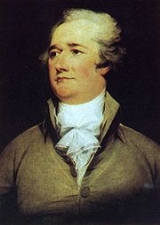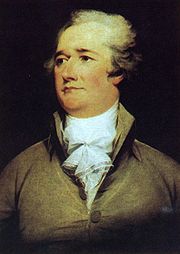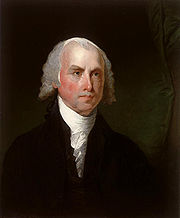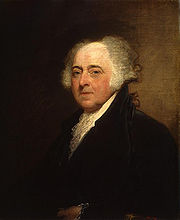
Federalist Era
Encyclopedia
The Federalist Era was a time period in American history from roughly 1789-1801 when the Federalist Party was dominant in American politics. This period saw the adoption of the United States Constitution
and the expansion of the federal government. In addition, the era saw the growth of a strong nationalistic government under the control of the Federalist Party. Among the most important events of this period was the foreign entanglements between France
and England
, the assertion of a strong, centralized federal government, and creation of political parties.
returned heavy Federalist majorities.
The first Anti-Federalist movement opposed the draft Constitution in 1788, primarily because they lack a Bill of Rights. The Anti-Federalists objected to the new powerful central government, the loss of prestige for the states, and saw the Constitution as a potential threat to personal liberties. During the ratification process the Anti-Federalists presented a significant opposition in all but three states. The major stumbling block for the Anti-Federalists, according to Elkins and McKitrick's The Age of Federalism was that the supporters of the Constitution had been more deeply committed, had cared more, and had outmaneuvered the less energetic opposition.
 The dynamic force in the Presidency of George Washington
The dynamic force in the Presidency of George Washington
was the secretary of the treasury, Alexander Hamilton
. Hamilton had the vision of a strong national government and a strong national economy, and he devised a complex multi-faceted program to achieve that goal, and simultaneously solve the debt problem of most of the states, create a financial system for national and international stability, pay off the national debt, and lay the infrastructure for further economic development. Hamilton's programs included the assumption of the state's Revolutionary war debts, the payoffs of the debts of the old Continental Congress, the payoffs of loans from foreign treasuries and investors, the creation of a system of taxes and tariffs to pay for the debt, and a First Bank of the United States
to handle the finances. Hamilton's programs were approved by Congress over the opposition of the old Anti—Federalists element, which increasingly coalesced under the leadership of Thomas Jefferson and James Madison. In order to build a national network in support of his programs, Hamilton created a coalition of supporters—often prominent businessmen and financiers—in every city and state. Hamilton's network of supporters grew into the "Federalist Party", which included most, but not all, of those Federalists who supported the Constitution in 1788. A major emphasis of Hamilton's policies and indeed the general outlook for the Federalist Party was that the federal government was to presided over the national economy..
. However the defeat of Adams in the election of 1800 and the death of Hamilton led to the decline of the Federalist Party from which it did not recover. While there were still Federalists after 1800, the party never again enjoyed the power and influence it had held earlier. One of the Federalists Era's greatest accomplishments was that republican government survived and took root in the United States.
 Republicans, or the Democratic-Republican Party, was founded in 1792 by Jefferson and James Madison
Republicans, or the Democratic-Republican Party, was founded in 1792 by Jefferson and James Madison
. The party was created in order to oppose the policies of Hamilton and the Federalist Party. Foreign policy issues were central; the party opposed the Jay Treaty of 1794 with Great Britain
(then at war with France) and supported good relations with France
before 1801. In great contrast to the Federalists the Republican supported a strict construction interpretation of the Constitution, and denounced many of Hamilton's proposals (especially the national bank) as unconstitutional. The party promoted states' rights and the primacy of the yeoman farmer over bankers, industrialists, merchants, and other monied interests. The party supported states' rights as a measure against the tyrannical nature of a large centralized government that they feared the Federal government could have easily become. It would be Jefferson and the Republican Party that would replace the Federalist Party domination of politics following the election of 1800 which would place Jefferson as the new President and end the Federalist reign as the strongest political party.
, and clearly defining Federalist and Republican points of view on all political questions. Chief among the conflict was that any form of understanding between the United States and Great Britain would pose a threat to the Franco-American relations. The treaty averted war and increased trade, a positive outcome for both sides. It gained the major American requirement: British withdrawal from the posts in the Northwest Territory
of America; wartime debts were sent for arbitration. The Republicans were furiously opposed to the Jay Treaty, and only Washington's intervention allowed it to pass. The Republicans charged that closer ties with Britain would undermine republican values and promote aristocracy, which they alleged was favored all along by the Federalists. Federalists said the country needed peace and prosperity, not another war with Britain. Voters lined up in the two parties based in large part on their opinion of the Jay Treaty.
XYZ Affair
The XYZ Affair
was a diplomatic incident that brought relations with France to an undeclared war. When Americans learned that the French demanded large bribes from the American delegation in order to continue negotiations, the political atmosphere quickly turned angry. Much of the Republican resistance to Adams' policies in Congress faded and Federalists and Adams greatly benefited from the surge of patriotic feeling. As tensions grew the Quasi-War
of 1798 broke out between French and American warships and merchant ships. The nation went on a war footing, with new taxes, a new army (headed by Washington and Hamilton), and the Alien and Sedition Acts
suppressing Republican dissenters. Republicans responded with the Virginia and Kentucky Resolutions, calling for states to interpose against illegal acts of the national government. Adams broke with the main wing of his Federalist party and sent new negotiators to end the conflict in 1800. Together with the rise of Napoleon, the conflict served to significantly weaken the affection that America had previously held for France.
 The Alien and Sedition Acts
The Alien and Sedition Acts
were among the most controversial acts established by the Federalist Party. These acts were four bills passed in 1798 by the Federalist Congress and signed into law by Adams. Defenders claimed the acts were designed to protect against alien citizens and to guard against seditious attacks from weakening the government. Opponents of the acts attacked on the grounds of being both unconstitutional and as way to stifle criticism of the administration. The Democratic-Republicans also asserted that the acts violated the rights of the states to act in accordance with the Tenth Amendment
. None of the four acts did anything to promote national unity against the French or any other country and in fact did a great deal to erode away what unity there already was in the country. The acts in general and the popular opposition to them were all bad luck for John Adams. A key factor in the uproar surrounding the Alien and Sedition Acts was that the very concept of seditious libel
was flatly incompatible with party politics. The Republicans, it appears had some understanding of this and realized that the ability to pass judgment on officeholders was essential to party survival. The Federalist Party seemed to have no inkling of this and in some sense seem to be lashing out at the concepts of party in general. What was clear was that the Republicans were becoming more focused in their opposition and more popular with the general population.
The years 1798-1800 corroded the prestige and authority of the Federalist Party. At both the national and local level the Federalists faced stiff Republican opposition. By mobilizing common voters, local republican insurgents built the popular constituency that the national leaders attached themselves to. Jefferson defeated Adams for the Presidency and the Republican Party made significant gains at all levels of the government with the election 1800. As the Federalist faded from the national spotlight a new political era would be ushered in with the Jefferson administration. The Federalist Party would continue to exist as a strong party in New England
and the Northeast, but without any strong leaders it eventually weakened and faded out within the first decade of the 19th-century.
United States Constitution
The Constitution of the United States is the supreme law of the United States of America. It is the framework for the organization of the United States government and for the relationship of the federal government with the states, citizens, and all people within the United States.The first three...
and the expansion of the federal government. In addition, the era saw the growth of a strong nationalistic government under the control of the Federalist Party. Among the most important events of this period was the foreign entanglements between France
France
The French Republic , The French Republic , The French Republic , (commonly known as France , is a unitary semi-presidential republic in Western Europe with several overseas territories and islands located on other continents and in the Indian, Pacific, and Atlantic oceans. Metropolitan France...
and England
England
England is a country that is part of the United Kingdom. It shares land borders with Scotland to the north and Wales to the west; the Irish Sea is to the north west, the Celtic Sea to the south west, with the North Sea to the east and the English Channel to the south separating it from continental...
, the assertion of a strong, centralized federal government, and creation of political parties.
Federalist Era begins
The United States Constitution was written in 1787 and unanimously ratified by the states in 1788, taking effect in 1789. The winning supporters of ratification of the Constitution were called Federalists, the opponents were called "Anti-Federalists." The immediate problem faced by the Federalists was not simply one of acceptance of the Constitution but the more fundamental concern of legitimacy for the government of the new republic. With this challenge in mind, the new national government needed to act with the idea that every act was being carried out for the first time and would therefore have great significance and be viewed along the lines of the symbolic as well as practical implications. The first elections to the new United States CongressUnited States Congress
The United States Congress is the bicameral legislature of the federal government of the United States, consisting of the Senate and the House of Representatives. The Congress meets in the United States Capitol in Washington, D.C....
returned heavy Federalist majorities.
The first Anti-Federalist movement opposed the draft Constitution in 1788, primarily because they lack a Bill of Rights. The Anti-Federalists objected to the new powerful central government, the loss of prestige for the states, and saw the Constitution as a potential threat to personal liberties. During the ratification process the Anti-Federalists presented a significant opposition in all but three states. The major stumbling block for the Anti-Federalists, according to Elkins and McKitrick's The Age of Federalism was that the supporters of the Constitution had been more deeply committed, had cared more, and had outmaneuvered the less energetic opposition.
Federalists v. Anti-Federalists

Presidency of George Washington
With inauguration on April 30, 1789, the presidency of George Washington initiated a significant leadership role over the United States. President Washington entered office with the full support of the national and state leadership, and established the executive and judicial branches of the federal...
was the secretary of the treasury, Alexander Hamilton
Alexander Hamilton
Alexander Hamilton was a Founding Father, soldier, economist, political philosopher, one of America's first constitutional lawyers and the first United States Secretary of the Treasury...
. Hamilton had the vision of a strong national government and a strong national economy, and he devised a complex multi-faceted program to achieve that goal, and simultaneously solve the debt problem of most of the states, create a financial system for national and international stability, pay off the national debt, and lay the infrastructure for further economic development. Hamilton's programs included the assumption of the state's Revolutionary war debts, the payoffs of the debts of the old Continental Congress, the payoffs of loans from foreign treasuries and investors, the creation of a system of taxes and tariffs to pay for the debt, and a First Bank of the United States
First Bank of the United States
The First Bank of the United States is a National Historic Landmark located in Philadelphia, Pennsylvania within Independence National Historical Park.-Banking History:...
to handle the finances. Hamilton's programs were approved by Congress over the opposition of the old Anti—Federalists element, which increasingly coalesced under the leadership of Thomas Jefferson and James Madison. In order to build a national network in support of his programs, Hamilton created a coalition of supporters—often prominent businessmen and financiers—in every city and state. Hamilton's network of supporters grew into the "Federalist Party", which included most, but not all, of those Federalists who supported the Constitution in 1788. A major emphasis of Hamilton's policies and indeed the general outlook for the Federalist Party was that the federal government was to presided over the national economy..
Rise of political parties
Federalists during the ratification period had been unified around the Constitution and support for its form of government. Following the acceptance of the Constitution, the initial Federalist movement faded briefly only to be taken up by a second movement centered upon the support for Alexander Hamilton's policies of a strong nationalist government, loose construction of the Constitution, and mercantile economic policies. The support around these policies eventually established the first official political party in the United States as the Federalist Party. The Party reached its political apex with the election of the strongly Federalist President John AdamsJohn Adams
John Adams was an American lawyer, statesman, diplomat and political theorist. A leading champion of independence in 1776, he was the second President of the United States...
. However the defeat of Adams in the election of 1800 and the death of Hamilton led to the decline of the Federalist Party from which it did not recover. While there were still Federalists after 1800, the party never again enjoyed the power and influence it had held earlier. One of the Federalists Era's greatest accomplishments was that republican government survived and took root in the United States.

James Madison
James Madison, Jr. was an American statesman and political theorist. He was the fourth President of the United States and is hailed as the “Father of the Constitution” for being the primary author of the United States Constitution and at first an opponent of, and then a key author of the United...
. The party was created in order to oppose the policies of Hamilton and the Federalist Party. Foreign policy issues were central; the party opposed the Jay Treaty of 1794 with Great Britain
Great Britain
Great Britain or Britain is an island situated to the northwest of Continental Europe. It is the ninth largest island in the world, and the largest European island, as well as the largest of the British Isles...
(then at war with France) and supported good relations with France
France
The French Republic , The French Republic , The French Republic , (commonly known as France , is a unitary semi-presidential republic in Western Europe with several overseas territories and islands located on other continents and in the Indian, Pacific, and Atlantic oceans. Metropolitan France...
before 1801. In great contrast to the Federalists the Republican supported a strict construction interpretation of the Constitution, and denounced many of Hamilton's proposals (especially the national bank) as unconstitutional. The party promoted states' rights and the primacy of the yeoman farmer over bankers, industrialists, merchants, and other monied interests. The party supported states' rights as a measure against the tyrannical nature of a large centralized government that they feared the Federal government could have easily become. It would be Jefferson and the Republican Party that would replace the Federalist Party domination of politics following the election of 1800 which would place Jefferson as the new President and end the Federalist reign as the strongest political party.
Foreign affairs
Jay's Treaty in 1794 was an essential marker and generally considered to be directly responsible for the full emergence of political parties in America in the First Party SystemFirst Party System
The First Party System is a model of American politics used by political scientists and historians to periodize the political party system existing in the United States between roughly 1792 and 1824. It featured two national parties competing for control of the presidency, Congress, and the states:...
, and clearly defining Federalist and Republican points of view on all political questions. Chief among the conflict was that any form of understanding between the United States and Great Britain would pose a threat to the Franco-American relations. The treaty averted war and increased trade, a positive outcome for both sides. It gained the major American requirement: British withdrawal from the posts in the Northwest Territory
Northwest Territory
The Territory Northwest of the River Ohio, more commonly known as the Northwest Territory, was an organized incorporated territory of the United States that existed from July 13, 1787, until March 1, 1803, when the southeastern portion of the territory was admitted to the Union as the state of Ohio...
of America; wartime debts were sent for arbitration. The Republicans were furiously opposed to the Jay Treaty, and only Washington's intervention allowed it to pass. The Republicans charged that closer ties with Britain would undermine republican values and promote aristocracy, which they alleged was favored all along by the Federalists. Federalists said the country needed peace and prosperity, not another war with Britain. Voters lined up in the two parties based in large part on their opinion of the Jay Treaty.
XYZ Affair
The XYZ Affair
XYZ Affair
The XYZ Affair was a 1798 diplomatic episode during the administration of John Adams that Americans interpreted as an insult from France. It led to an undeclared naval war called the Quasi-War, which raged at sea from 1798 to 1800...
was a diplomatic incident that brought relations with France to an undeclared war. When Americans learned that the French demanded large bribes from the American delegation in order to continue negotiations, the political atmosphere quickly turned angry. Much of the Republican resistance to Adams' policies in Congress faded and Federalists and Adams greatly benefited from the surge of patriotic feeling. As tensions grew the Quasi-War
Quasi-War
The Quasi-War was an undeclared war fought mostly at sea between the United States and French Republic from 1798 to 1800. In the United States, the conflict was sometimes also referred to as the Franco-American War, the Pirate Wars, or the Half-War.-Background:The Kingdom of France had been a...
of 1798 broke out between French and American warships and merchant ships. The nation went on a war footing, with new taxes, a new army (headed by Washington and Hamilton), and the Alien and Sedition Acts
Alien and Sedition Acts
The Alien and Sedition Acts were four bills passed in 1798 by the Federalists in the 5th United States Congress in the aftermath of the French Revolution's reign of terror and during an undeclared naval war with France, later known as the Quasi-War. They were signed into law by President John Adams...
suppressing Republican dissenters. Republicans responded with the Virginia and Kentucky Resolutions, calling for states to interpose against illegal acts of the national government. Adams broke with the main wing of his Federalist party and sent new negotiators to end the conflict in 1800. Together with the rise of Napoleon, the conflict served to significantly weaken the affection that America had previously held for France.
The fall of the Federalists

Alien and Sedition Acts
The Alien and Sedition Acts were four bills passed in 1798 by the Federalists in the 5th United States Congress in the aftermath of the French Revolution's reign of terror and during an undeclared naval war with France, later known as the Quasi-War. They were signed into law by President John Adams...
were among the most controversial acts established by the Federalist Party. These acts were four bills passed in 1798 by the Federalist Congress and signed into law by Adams. Defenders claimed the acts were designed to protect against alien citizens and to guard against seditious attacks from weakening the government. Opponents of the acts attacked on the grounds of being both unconstitutional and as way to stifle criticism of the administration. The Democratic-Republicans also asserted that the acts violated the rights of the states to act in accordance with the Tenth Amendment
Tenth Amendment to the United States Constitution
The Tenth Amendment to the United States Constitution, which is part of the Bill of Rights, was ratified on December 15, 1791...
. None of the four acts did anything to promote national unity against the French or any other country and in fact did a great deal to erode away what unity there already was in the country. The acts in general and the popular opposition to them were all bad luck for John Adams. A key factor in the uproar surrounding the Alien and Sedition Acts was that the very concept of seditious libel
Seditious libel
Seditious libel was a criminal offence under English common law. Sedition is the offence of speaking seditious words with seditious intent: if the statement is in writing or some other permanent form it is seditious libel...
was flatly incompatible with party politics. The Republicans, it appears had some understanding of this and realized that the ability to pass judgment on officeholders was essential to party survival. The Federalist Party seemed to have no inkling of this and in some sense seem to be lashing out at the concepts of party in general. What was clear was that the Republicans were becoming more focused in their opposition and more popular with the general population.
The years 1798-1800 corroded the prestige and authority of the Federalist Party. At both the national and local level the Federalists faced stiff Republican opposition. By mobilizing common voters, local republican insurgents built the popular constituency that the national leaders attached themselves to. Jefferson defeated Adams for the Presidency and the Republican Party made significant gains at all levels of the government with the election 1800. As the Federalist faded from the national spotlight a new political era would be ushered in with the Jefferson administration. The Federalist Party would continue to exist as a strong party in New England
New England
New England is a region in the northeastern corner of the United States consisting of the six states of Maine, New Hampshire, Vermont, Massachusetts, Rhode Island, and Connecticut...
and the Northeast, but without any strong leaders it eventually weakened and faded out within the first decade of the 19th-century.
See also
- First Party SystemFirst Party SystemThe First Party System is a model of American politics used by political scientists and historians to periodize the political party system existing in the United States between roughly 1792 and 1824. It featured two national parties competing for control of the presidency, Congress, and the states:...
- Presidency of George WashingtonPresidency of George WashingtonWith inauguration on April 30, 1789, the presidency of George Washington initiated a significant leadership role over the United States. President Washington entered office with the full support of the national and state leadership, and established the executive and judicial branches of the federal...
- History of the United States (1789–1849)History of the United States (1789–1849)With the election of George Washington as the first president in 1789, the new government acted quickly to rebuild the nation's financial structure. Enacting the program of Treasury Secretary Alexander Hamilton, the government assumed the Revolutionary war debts of the state and the national...

